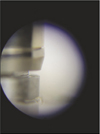Abstract
Purpose
The object of this study was to determine if the low-priced alloy and metal UCLA abutment could be available for manufacturing bar-retained framework of implant prosthesis.
Materials and methods
Bar structure was classified into 4 groups, The specimen of group 1 and 2 were based on casting high noble metal alloys and noble metal alloys with gold UCLA abutment. The specimen of group 3 and 4 were based on casting noble metal alloys and base metal alloys with metal UCLA abutment. Cast bar structure was installed in an acrylic resin model and only the screw on the hexed abutment side was tightened to 20 Ncm. On the opposite side, vertical discrepancy was measured with stereo microscope from front, back, and lateral side of the implant-abutment interface. One-way ANOVA was performed to analyze the marginal fit discrepancy.
Figures and Tables
References
1. Brånemark PI, Hansson BO, Adell R, Breine U, Lindström J, Hallén O, Ohman A. Osseointegrated implants in the treatment of the edentulous jaw. Experience from a 10-year period. Scand J Plast Reconstr Surg Suppl. 1977. 16:1–132.
2. Spiekermann H, Jansen UK, Richter EJ. A 10-year follow-up study of IMZ and TPS implants in the edentulous mandible using bar-retained overdentures. Int J Oral Maxillofac Implants. 1995. 10:231–243.
3. Fanuscu MI, Caputo AA. Influence of attachment systems on load transfer of an implant-assisted maxillary overdenture. J Prosthodont. 2004. 13:214–220.

4. Freeman C, Brook I, Joshi R. Long term follow-up of implant stabilized overdentures. Eur J Prosthodont Restor Dent. 2001. 9:147–150.
5. Karabuda C, Tosun T, Ermis E, Ozdemir T. Comparison of 2 retentive systems for implant-supported overdentures: soft tissue management and evaluation of patient satisfaction. J Periodontol. 2002. 73:1067–1070.

6. Lewis SG, Beumer J III, Hornburg W, Moy P. The UCLA abutment. Int J Oral Maxillofac Implants. 1988. 3:183–189.
8. Lewis SG, Avera S, Engleman M, Beumer J III. The restoration of improperly inclined osseointegrated implants. Int J Oral Maxillofac Implants. 1989. 4:147–152.
9. Lewis SG, Llamas D, Avera S. The UCLA abutment: a four-year review. J Prosthet Dent. 1992. 67:509–515.

10. O'Brien WJ. O'Brien WJ, editor. Base metal casting alloys. Dental material and their selection. 1997. Carol Stream: Quintessence;259–268.
11. Kano SC, Bonfante G, Hussne R, Siqueira AF. Use of base metal casting alloys for implant framework : Marginal accuracy analysis. J Appl Oral Sci. 2004. 12:337–343.

12. White GE. Osseointegrated dental technology. 1993. London: Quintessence;82–83.
13. Kano SC, Valle AL, Pegoraro LF, Campos A Jr. Disadjustment of prosthetic components using different alloys. J Dent Res. 1995. 74:806.
14. Tan KB, Rubenstein JE, Nicholls JI, Yuodelis RA. Three-dimensional analysis of the casting accuracy of one-piece, osseointegrated implant-retained prostheses. Int J Prosthodont. 1993. 6:346–363.
15. Mitha T, Owen CP, Howes DG. The three-dimensional casting distortion of five implant-supported frameworks. Int J Prosthodont. 2009. 22:248–250.
16. Jemt T. Failures, complications in 391 consecutively inserted fixed prostheses supported by Brånemark implants in edentulous jaws: A study of treatment from the time of prosthesis placement to the first annual checkup. Int J Oral Maxillofac Implants. 1991. 6:270–276.
17. Michelinakis G, Barclay CW, Smith PW. The influence of interimplant distance and attachment type on the retention characteristics of mandibular overdentures on 2 implants: Initial retention values. Int J Prosthodont. 2006. 19:507–512.
18. Zarb GA, Symington JM. Osseointegrated dental implants: Preliminary report on a replication study. J Prosthet Dent. 1983. 50:271–276.

20. Skalak R. Biomechanical considerations in osseointegrated prostheses. J Prosthet Dent. 1983. 49:843–848.

21. Adell R, Lekholm U, Rocker B, Brånemark PI. A 15-year study of osseointegrated implants in the treatment of the edentulous jaw. Int J Oral Surg. 1981. 10:387–416.

22. Adell R, Eriksson B, Lekholm U, Brånemark PI, Jemt T. A long-term follow-up of osseointegrated implants in the treatment of totally edentulous jaws. Int J Oral Maxillofac Implants. 1990. 5:347–359.
23. Carr AB, Stewart RB. Full-arch implant framework casting accuracy: Preliminary in vitro observation for in vivo testing. J Prosthodont. 1993. 2:2–8.

24. Carr AB. Comparison of impression techniques for a five-implant mandibular model. Int J Oral Maxillofac Implants. 1991. 6:448–455.
25. Linke BA, Nicholls JI, Faucher RR. Distortion analysis of stone casts made from impression materials. J Prosthet Dent. 1985. 54:794–802.

26. Inturregui J, Aquilino SA, Ryther JS, Lund PS. Evaluation of three impression techniques for osseointegrated oral implants. J Prosthet Dent. 1993. 69:503–509.

27. Assif D, Marshak B, Schmidt A. Accuracy of implant impression techniques. Int J Oral Maxillofac Implants. 1996. 11:216–222.

28. Humphries RM, Yaman P, Bloem T. The accuracy of implant master casts constructed from transfer impressions. Int J Oral Maxillofac Implants. 1990. 5:331–336.
29. Gettleman L, Ryge G. Accuracy of stone, metal and plastic die material. J Calif Dent Assoc. 1970. 46:28–31.
30. Romero GG, Engelmeier R, Powers JM, Canterbury AA. Accuracy of three corrective techniques for implant bar fabrication. J Prosthet Dent. 2000. 84:602–607.

31. Oh KT, Kim KN. Electrochemical properties of suprastructures galvanically coupled to a titanium implant. J Biomed Mater Res B Appl Biomater. 2004. 70:318–331.





 PDF
PDF ePub
ePub Citation
Citation Print
Print










 XML Download
XML Download